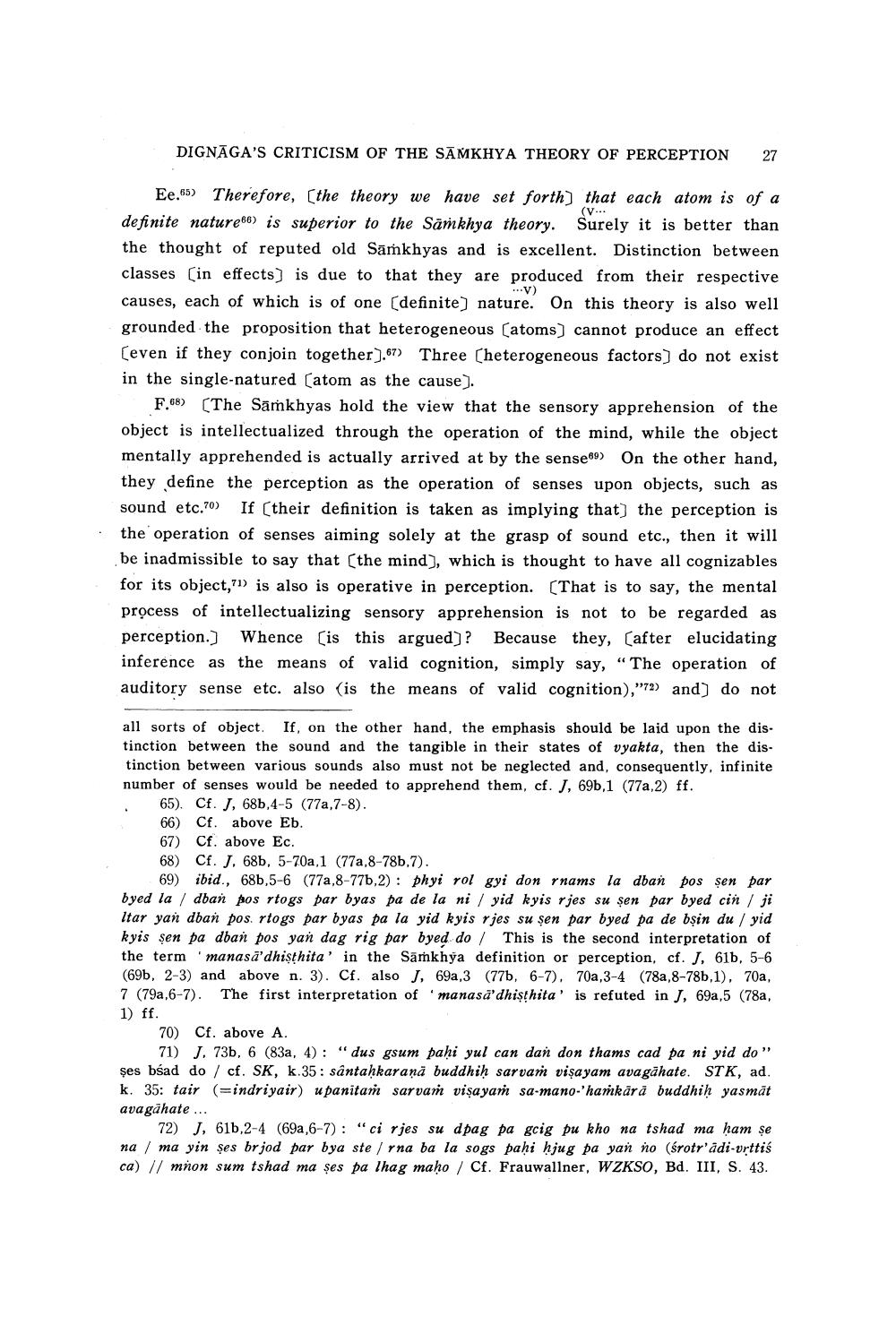________________
DIGNĀGA'S CRITICISM OF THE SAMKHYA THEORY OF PERCEPTION
27
Ee.65) Therefore, (the theory we have set forth) that each atom is of a definite nature66) is superior to the Samkhya theory. Surely it is better than the thought of reputed old Samkhyas and is excellent. Distinction between classes (in effects) is due to that they are produced from their respective causes, each of which is of one (definite) nature. On this theory is also well grounded the proposition that heterogeneous (atoms) cannot produce an effect (even if they conjoin together).67) Three (heterogeneous factors) do not exist in the single-natured (atom as the cause).
F.68) (The Samkhyas hold the view that the sensory apprehension of the object is intellectualized through the operation of the mind, while the object mentally apprehended is actually arrived at by the sense89) On the other hand, they define the perception as the operation of senses upon objects, such as sound etc.70) If (their definition is taken as implying that) the perception is the operation of senses aiming solely at the grasp of sound etc., then it will be inadmissible to say that the mind), which is thought to have all cognizables for its object,"") is also is operative in perception. (That is to say, the mental process of intellectualizing sensory apprehension is not to be regarded as perception.) Whence (is this argued)? Because they, (after elucidating inference as the means of valid cognition, simply say, "The operation of auditory sense etc. also (is the means of valid cognition),"72) and do not
all sorts of object. If, on the other hand, the emphasis should be laid upon the dis. tinction between the sound and the tangible in their states of vyakta, then the distinction between various sounds also must not be neglected and, consequently, infinite number of senses would be needed to apprehend them, cf. J, 69,1 (77a,2) ff.
65). Cf. J, 68,4-5 (77a, 7-8). 66) Cf. above Eb. 67) Cf. above Ec. 68) Cf. J. 68b, 5-70a, 1 (77a.8-78b.7).
69) ibid., 686,5-6 (77a,8-775,2): phyi rol gyi don rnams la dban pos sen par byed la / dban pos rtogs par byas pa de la ni / yid kyis rjes su sen par byed cin / ji Itar yan dban pos rtogs par byas pa la yid kyis rjes su sen par byed pa de bşin du / yid kyis sen pa dban pos yan dag rig par byed do / This is the second interpretation of the term 'manasā'dhisthita' in the Sāmkhya definition or perception, cf. J, 61b, 5-6 (69b, 2-3) and above n. 3). Cf. also J, 69,3 (77b, 6-7). 70a,3-4 (78a,8-78b,1). 70a, 7 (79a,6-7). The first interpretation of 'manasā'dhisthita' is refuted in J, 69,5 (78a, 1) ff.
70) Cf. above A.
71) J. 73b, 6 (83a, 4) : "dus gsum pahi yul can dan don thams cad pa ni yid do" şes bśad do / cf. SK, k.35: sântahkarana buddhih sarvan vişa yam avagähate. STK, ad. k. 35: tair (=indri yair) u panitan sarvam visayam sa-mano-'hankärä buddhih yasmāt avagahate ...
72) J, 616,2-4 (69a,6-7): "ci rjes su dpag pa gcig pu kho na tshad ma ham se na / ma yin şes br jod par bya ste / rna ba la sogs pahi hjug pa yan no (śrotr'adi-vrttiś ca) // mnon sum tshad ma șes pa lhag maḥo / Cf. Frauwallner, WZKSO, Bd. III, S. 43.




